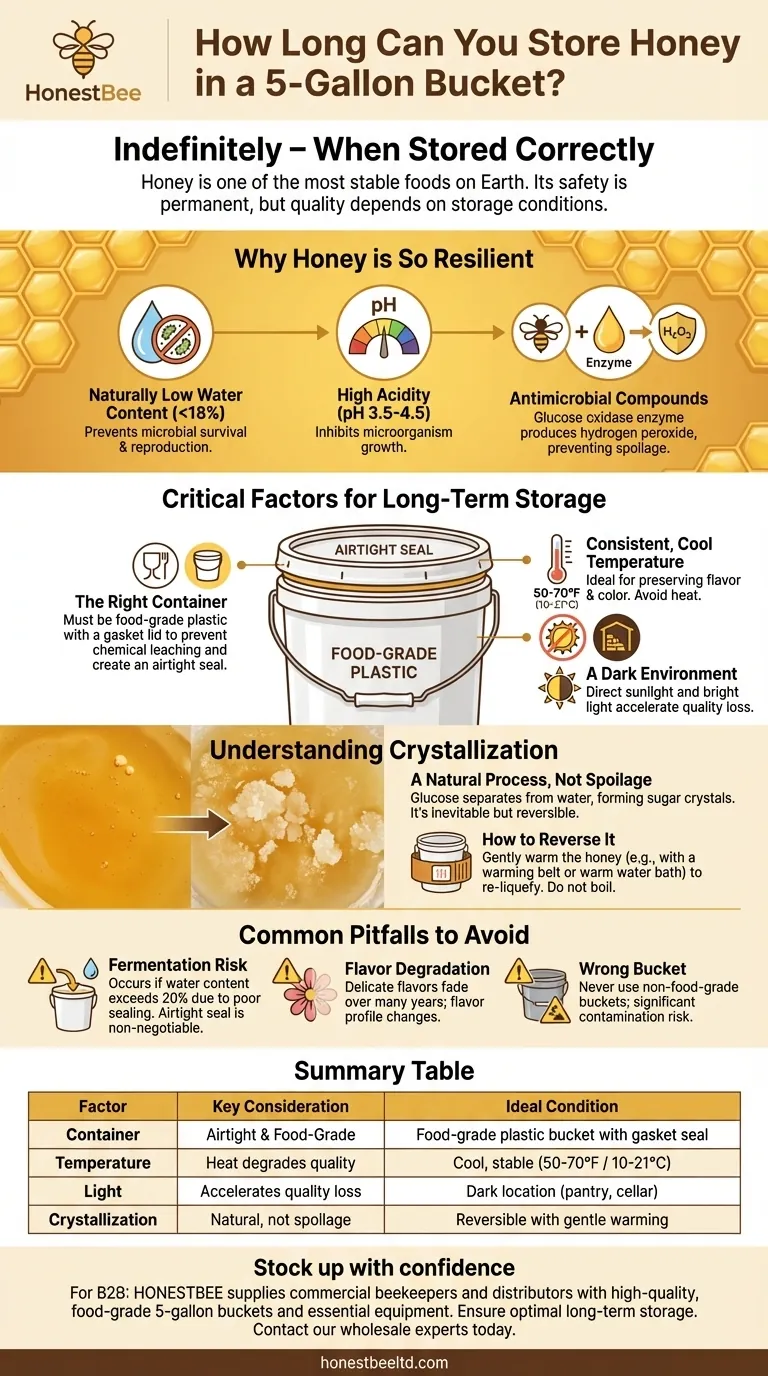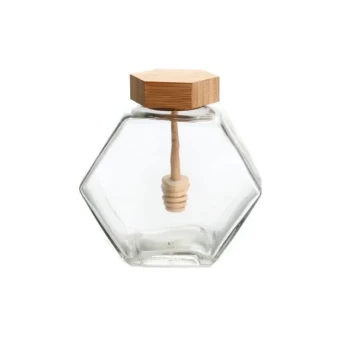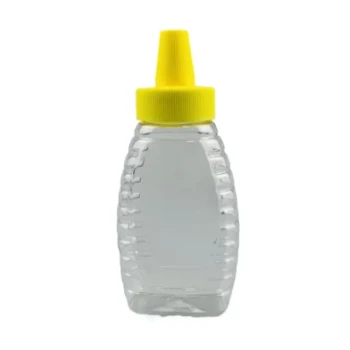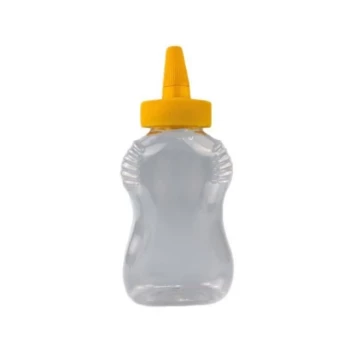When stored correctly, honey in a 5-gallon bucket can last indefinitely. Due to its natural chemical makeup, honey is one of the most stable foods on the planet and will remain safe to eat for decades, even centuries. However, while its safety is virtually permanent, its quality—taste, color, and texture—will change over time based entirely on storage conditions.
The core principle to understand is that honey's longevity isn't limited by a date, but by its environment. A properly sealed, food-grade 5-gallon bucket stored in a cool, dark place is the ideal method for preserving honey's quality for years and its safety forever.

Why Honey is So Resilient
Honey's incredible shelf life isn't an accident; it's the result of several natural properties working in perfect harmony. Understanding these factors helps explain why storage conditions are so critical.
Naturally Low Water Content
Honey has a very low moisture content, typically below 18%. This creates an environment where bacteria, yeast, and other microbes simply cannot survive or reproduce.
High Acidity
Honey is naturally acidic, with a pH level between 3.5 and 4.5. This high acidity is another powerful barrier that inhibits the growth of virtually all microorganisms.
Antimicrobial Compounds
Bees add an enzyme called glucose oxidase to nectar. When honey is exposed to moisture, this enzyme produces small amounts of hydrogen peroxide, which acts as a potent antimicrobial agent that prevents spoilage.
The Critical Factors for Long-Term Storage
While honey won't spoil, its quality can degrade. Your goal with long-term storage is to slow this degradation. A 5-gallon bucket is an excellent vessel, provided you control these three environmental factors.
The Right Container
The bucket itself is paramount. It must be food-grade plastic to prevent harmful chemicals from leaching into your honey over time. It also needs a lid with a gasket to create a truly airtight seal.
Consistent, Cool Temperature
Heat is the primary enemy of honey's quality. Storing it in a consistently cool location, ideally between 50-70°F (10-21°C), is best. Warm temperatures will darken the honey and degrade its delicate flavors and aromas.
A Dark Environment
Direct sunlight and even consistent bright indoor light will accelerate the breakdown of enzymes and darken the honey. A dark pantry, cellar, or closet is the ideal storage location.
Understanding Crystallization: An Inevitable Change
Over time, almost all pure honey will crystallize. This is a common point of confusion, but it is not a sign of spoilage.
What Is Crystallization?
Crystallization is a natural process where the glucose in honey separates from the water, forming sugar crystals. This simply changes the honey's texture from liquid to a semi-solid state.
Why It Happens
The process is influenced by the honey's specific glucose-to-fructose ratio and is often accelerated by temperature fluctuations. Storing honey in a cool, stable environment can slow crystallization, but it will likely happen eventually.
How to Reverse It
Crystallization is completely reversible. You can re-liquefy the honey by gently warming it. For a 5-gallon bucket, this can be done with a specialized bucket warming belt or by placing the entire bucket in a larger tub of warm (not boiling) water.
Common Pitfalls to Avoid
Mistakes in storage can compromise your honey, not by making it unsafe, but by damaging its quality or introducing the only real threat it faces.
Fermentation Risk
The only way honey can truly spoil is through fermentation. This occurs if the water content rises above 20%, usually from absorbing moisture from the air. This is why an airtight seal is non-negotiable for long-term storage, especially in humid climates.
Flavor and Aroma Degradation
Even under ideal conditions, the delicate floral notes in honey will fade over many years. The flavor profile will change, often becoming stronger and less complex.
Using the Wrong Bucket
Never use a bucket from a hardware store or one that previously held non-food items. The risk of chemical contamination is significant and makes the honey unsafe for consumption.
Making the Right Choice for Your Goal
Your storage strategy depends on what you want to preserve: safety or peak quality.
- If your primary focus is indefinite food safety: Use a sealed, food-grade bucket and keep it in a dry place. The honey will remain safe to eat almost forever.
- If your primary focus is preserving peak flavor: Store the bucket in a cool, dark, and temperature-stable environment like a cellar. While it will last much longer, aim to use it within a few years for the best taste.
- If your honey crystallizes: Recognize this as a natural process and gently warm only what you need to use, as repeated heating can degrade quality.
Proper storage is not about preventing spoilage, but about preserving the remarkable quality of the honey for as long as you need it.
Summary Table:
| Factor | Key Consideration | Ideal Condition |
|---|---|---|
| Container | Must be airtight and food-grade | Food-grade plastic bucket with gasket seal |
| Temperature | Heat degrades flavor and color | Cool, stable (50-70°F / 10-21°C) |
| Light | Light accelerates quality loss | Dark location (pantry, cellar) |
| Crystallization | Natural process, not spoilage | Reversible with gentle warming |
Stock up with confidence for your apiary or distribution business. HONESTBEE supplies commercial beekeepers and distributors with high-quality, food-grade 5-gallon buckets and essential beekeeping equipment designed for optimal, long-term honey storage. Ensure your product maintains its quality from hive to market. Contact our wholesale experts today to discuss your bulk supply needs.
Visual Guide

Related Products
- Food Grade Plastic Honey Bucket Pail for Beekeeping
- Hexagonal Glass Honey Jar with Wooden Lid Integrated Dipper Elegant Functional Storage
- Classic Drum Shaped Glass Honey Jar with Airtight Lid
- Classic Beehive Honey Bottle Jar with Squeeze Dispenser Lid
- Ergonomic Squeezable Honey Bottle with Precision Twist Nozzle Cap
People Also Ask
- How heavy is a 5 gallon bucket of honey? A Beekeeper's Guide to Handling & Measuring
- Why might producers choose plastic containers for honey? A Guide to Cost-Effective & Durable Packaging
- What types of containers are ideal for storing liquid honey? Preserve Quality with Glass or Plastic
- What are plastic buckets called? The Essential Guide to Plastic Pails
- Can you store honey in a plastic bucket? Yes, with the right food-grade HDPE.



















